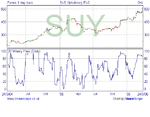CityTrader
Established member
- Messages
- 666
- Likes
- 26
A view I have always had, and frequently mention whenever anyone ever asks me, BUT todays ( Sat) Times, page 57 Robert Cole commentary claims that his contacts have finally found a use for charts- to cover up his insider dealings! his view of charts :-
" I thought he would agree with me (and most of the rest of the stock market community) in viewing charts as hocus-pocus"
Now I guess the Insider dealing argument is a whole different ball game, but and interesting article never-the-less..
CT
" I thought he would agree with me (and most of the rest of the stock market community) in viewing charts as hocus-pocus"
Now I guess the Insider dealing argument is a whole different ball game, but and interesting article never-the-less..
CT

